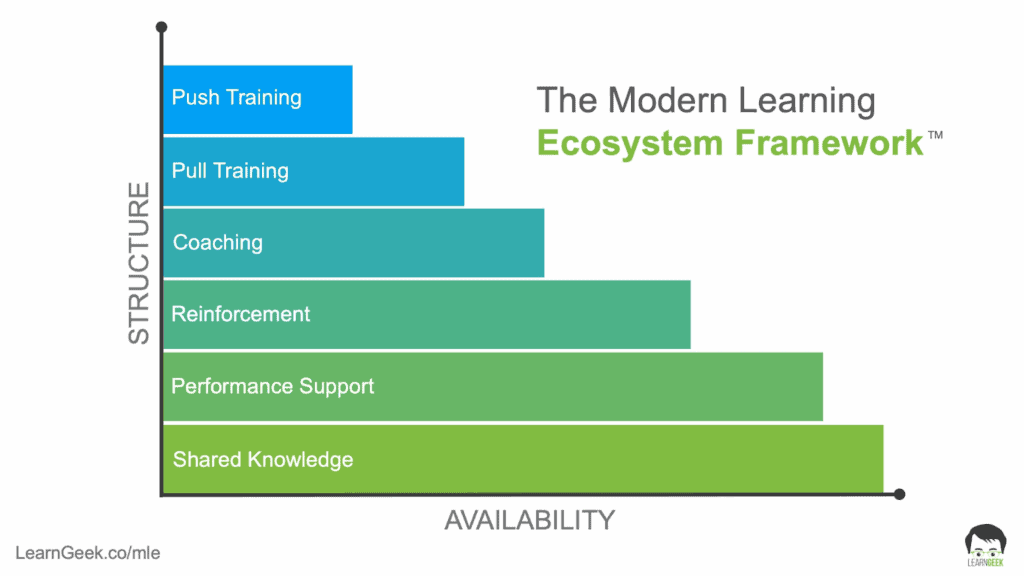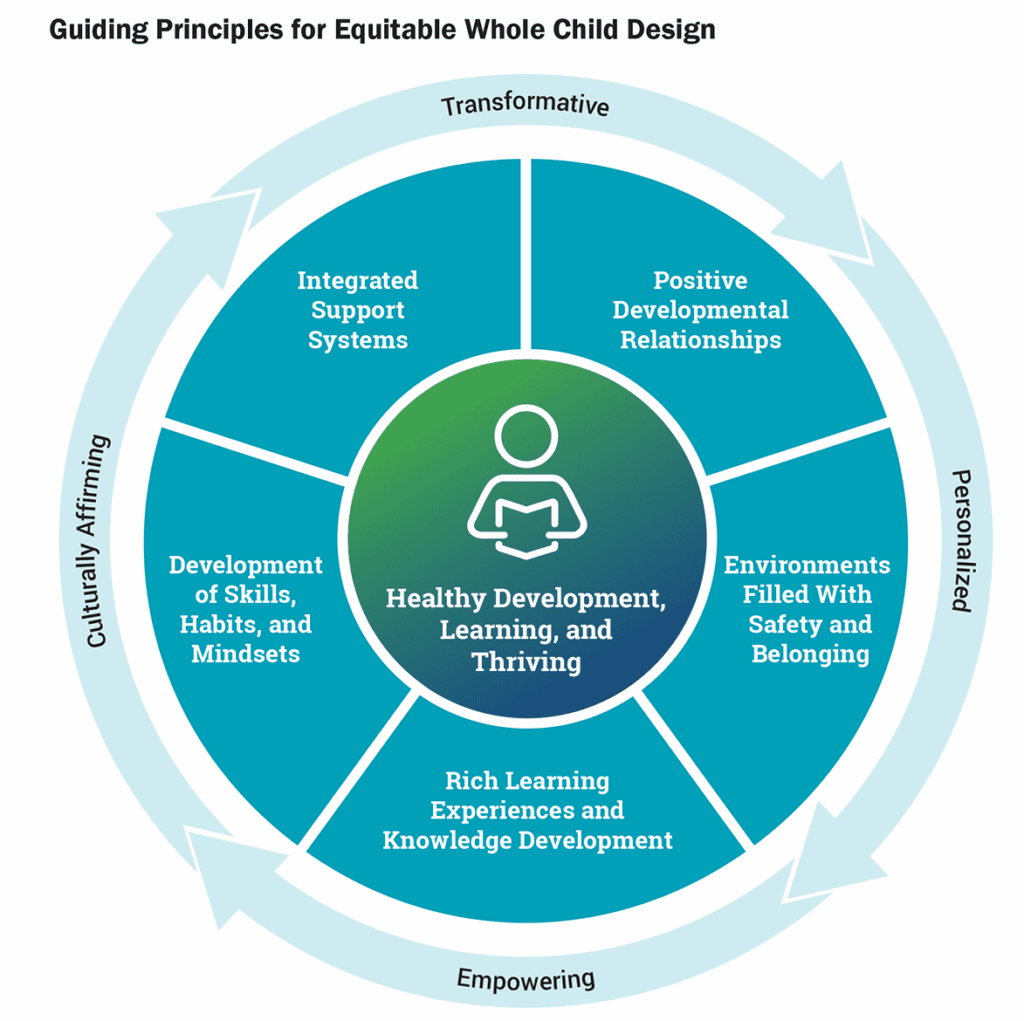How can schools redesign their systems to support accelerated learning?
A shift to a learning acceleration model provides every student, particularly those who have been systematically left behind by traditional schooling, with the opportunity to access high-quality instruction that leads to academic achievement and social-emotional well-being. Individual teachers in classrooms alone cannot make this happen, however. To support effective learning acceleration, schools and districts can engage in systems thinking to implement several structural changes that create the right conditions for educators and students to sustainably and permanently shift toward a learning acceleration model. California’s Statewide System of Support exists to assist schools and districts with this type of deep, layered, and systemic change.
This section examines five areas that school system leaders can strategically focus on to create the conditions for a sustainable and successful transformation into a learning acceleration-focused system.
Adopt an Acceleration Strategy
Systems that have had the most success in transitioning to a learning acceleration model have all adopted a continuous improvement approach to their work. Continuous improvement is a process of identifying what is working and what needs to change, developing a sound, evidence-based plan, implementing the plan, and using data to monitor outcomes and make timely adjustments to improve those outcomes. This approach is based on the belief that making sustainable change takes time, involves collective effort, and requires constant adaptation based on data and learning. While there are several versions of the model, all include some version of the components described below:
- Shared vision and goals.
Everyone in the organization needs to be able to answer the question, What are we trying to do, and why are we doing it? in the same way. This requires a shared and clear vision of what successful learning acceleration looks like for all students, as well as a common language to discuss what learning acceleration is and what it isn’t. This shared vision and set of goals should be reflected in key documents such as your Local Control Accountability Plan (LCAP), tech plan, and MTSS plan, to ensure learning acceleration is centered in your work, efforts are aligned toward that purpose across all parts of the system, and visible for all partners to see. Designing or selecting a model for learning acceleration that illustrates that vision, such as the BRIDGES to Learning Acceleration model, may be helpful in creating a shared vision and language for the community. Then, this Learning Acceleration Roadmap toolkit can help school sites and/or districts to implement and iterate learning acceleration objectives to support students in reaching grade-level standards. - Engaged and motivated partners.
When educators, students, families, and communities are deeply involved in creating solutions that address their own unique needs, those solutions are more likely to be effective and equitable. District and school teams may consider convening a group of partners representative of the community to build, execute, and communicate the system or school acceleration plan. Authentic collaboration with your community will help clarify the reasons behind this change and foster motivation to engage. This PAL may be a valuable resource for building awareness, urgency, and knowledge amongst partner groups. Acknowledge and make space for the emotions that will arrive as you collectively work through the stages of change. Establish clear processes for communication, dialogue, and feedback to ensure that ideas are heard, challenges are thoroughly addressed, and all community members remain engaged. Be sure the needs of students and families, especially the most vulnerable, as well as the voices of teachers, school leaders, and staff, are incorporated throughout the process of developing your approach to learning acceleration. To learn more about establishing authentic community partnerships for systems change, check out the CCEE’s Community Engagement Initiative’s Learning Modules. - Ongoing and sustainable data use to drive continuous improvement.
Learning acceleration — both at the classroom and system levels — requires careful and regular analysis of data to determine next steps. All partners need to be able to answer questions such as What outcomes are we trying to achieve? And how will we know our efforts are making a difference?
Start by assessing your current state. Where is your system in relation to your goals? Where are your strengths? What do you already have in place? Where do you need to focus? Who is experiencing success and who is not? Ask educators, leaders, students, and families for input, walk through classrooms to understand what is happening in instruction now, and review current data, materials, lessons, and resources in use to gain a clear picture of where your system stands.
Create a sustainable data collection system. Know what implementation and impact data you need to collect and from which sources, and build pathways to ensure you can access and use that data in a timely manner. If you can utilize existing data sources to gather this information, it can reduce user fatigue and increase the sustainability of your data collection efforts. Remember that data collection takes time and several sources to fully understand what is happening. Start with what you have and build sustainably from there.
Then, set regular times for your team to review, analyze, reflect on, and act on the data to support quick course corrections. Create structures to review, synthesize, and analyze the data. Set aside time with the appropriate partners at strategic points to review the findings, ask questions, make adjustments, and determine next steps. Ensure the process is straightforward and transparent to all parties involved. Determine when and how you will share your findings with others. Sharing and including appropriate partners in the creation of your plan helps make everyone accountable.
Use the data to create a roadmap to success that is aligned with goals and incorporates input from engaged participants. Be sure to include clear deliverables at each step to help everyone stay on track and ensure a smooth process. Create space for the team to meet regularly to update the process, problem-solve, and share ideas as new data becomes available.
Commit to continuous improvement. Signal to engaged participants early that this will be an interactive and iterative process linked to real-time data. This means changes will be made as your team learns, so flexibility will be a critical mindset for success. Frameworks can help your team develop a common language and a clear vision of the process, making the work more efficient and collaborative. Consider using existing continuous improvement models and resources to help ease the burden, such as those listed on CDE’s Continuous Improvement Resources webpage.
The New Teacher Project (TNTP) developed this graphic as part of their Learning Acceleration Guide to illustrate the components of a learning acceleration strategy that may be useful in visualizing the process described above.

For more on utilizing a systems thinking approach to engage in continuous improvement for the purposes of learning acceleration, explore the following resources:
- Policy Analysis for California Education’s (PACE) report on CCEE’s Intensive Assistance Model pilot, “What Does It Take to Accelerate the Learning of Every Child?”
- CCEE’s Levers for System Change self-assessment tool
- CCEE and Dr. Douglas Reeves: The New Model of Change Leadership
- CCEE and TNTP: Video: Developing and implementing a Learning Acceleration Plan
Invest in Essential Resources for Effective Acceleration
Building learning acceleration-centric systems requires investment in the resources necessary to create healthy working conditions for both adults and students within the system. In alignment with the adopted learning acceleration strategy, systems need to:
- Allocate funding toward the acceleration strategy.
If learning acceleration is at the center of education system decision-making, funding should follow. High-impact tutoring, high-quality instructional materials, instructional coaching, professional learning, and education technology to support personalization all require funding to begin and sustain over time. Collaborate with your team to explore potential repurposing of funding to support learning acceleration efforts. Systems may also want to examine existing resources that can be leveraged to support learning acceleration, like the Learning Recovery Emergency Block Grant. Accessing these funds requires completing a system needs assessment that can be organized around similar goals to learning acceleration. Aligned with resource prioritization, improvement, and accountability plans, like the Local Control Accountability Plan, should be developed so goals reflect a commitment to learning acceleration. - Invest in High-Quality Instructional Materials (HQIM) for all grade levels and courses.
Research has consistently shown that learning acceleration is more successful when educators have access to grade-level-aligned, culturally relevant, and high-quality instructional materials, along with the accompanying assessments and learning progressions that support the design of impactful and targeted instruction. Systems can ensure educators and tutors have the tools to assess student understanding and identify areas where prerequisite skills need to be addressed. Visit the Strategic Content Instruction section for more on this topic. - Get creative about time and structures.
Finding the time during the school day to offer flexible learning without taking away from core instruction will require some creativity. Research has shown that when teachers and schools adopt new models and structures for organizing student learning, which often involve a bold rethinking of time, grouping, and staffing models, students make rapid gains. Systems can work with school leaders and educators to review data alongside contextual and community needs and preferences to rethink:
- The daily schedule. How might you rework the daily schedule to integrate Tier 2 and 3 supports and personalized acceleration structures into the school day? Does your schedule allow for cross-class or grade groupings?
- Access to high-impact tutoring. Tutoring is most effective when students work with the same highly effective tutor at least three times a week for 30-60 minutes during the school day. School systems can be strategic about planning when tutoring will happen and how. For more on this topic, visit the Conditions for Personalized Learning section.
- The school calendar. How might before- or after-school opportunities, summer programs, or extended-year supports provide additional opportunities for every student to access the personalized learning opportunities they need to accelerate their progress? How can the system ensure every student can access these opportunities?
- Staffing. How can decisions about retention, assignment, and recruitment be developed based on data about student needs and educator strengths to maximize this important resource?
- Partner with organizations with demonstrated expertise.
School systems do not need to reinvent everything required to implement learning acceleration effectively. To ensure all students receive tailored learning, consider partnering with carefully vetted organizations that have expertise in your curriculum, high-impact tutoring, or other areas of need. For example, partner with a local college or university to offer students work-study funding to serve as tutors. Or, select a company that offers high-quality tutors using this guidance for tutor provider selection created by the National Student Support Accelerator. Similarly, your organization may want to consider where instructional materials are selected and how educators learn to use them effectively. For example, your organization may want to consider using guidance offered by the California Curriculum Collaborative or partnering directly with them to plan your approach.
Additionally, consider forming connections with community-based organizations (CBOs) that are committed to supporting students’ learning. Partnering with organizations that may already be working with students in after-school programs, for example, can help with knowledge development, resource alignment, and staffing are all crucial parts of a learning acceleration success plan. If your school is looking to refine or expand those partnerships, county offices of education often have lists of approved service providers that may provide a good starting point.
- Select technology that supports learning acceleration for educators and students.
Thoughtfully selected technology can enable enhanced personalization and engagement for students, creating more supportive and equitable learning cultures in schools and districts. It can also expedite the process of data collection and analysis for educators, thereby creating more time for them to focus on personalized planning and adaptation – all crucial aspects of learning acceleration. Adopting personalized learning technologies that align with the school or district’s vision of personalization for learning acceleration and supporting educators in creating content for blended learning, playlists, or flipped instruction is a positive step school systems can take to enhance learning acceleration efforts. As systems consider technology, it is also essential to consider issues of equitable access. For example, if educators are transitioning to a flipped instruction model, how will schools ensure that every student can access the material at home? Reducing barriers to technological use is just as important as investing in the technology itself.
Collectively, these investments ensure the conditions for learning acceleration exist at the systems level and allow educators and leaders to focus on the work of personalizing learning for students, thereby decreasing the time it takes to establish a successful learning acceleration system.
Support Educators As They Implement Acceleration
Educators will need consistent time, professional learning, and support to effectively make the shift to learning acceleration. Remember, learning acceleration requires all educators to teach in new ways —relying on a shift in mindset and practice—so everyone will need support in making this change. Remember that change is part of the improvement process journey. Our work in education is always evolving in response to what we learn about students’ needs, new research on learning, etc. So, building systems that expect and support adaptation to ensure teaching and learning reflect current understandings and best practices is essential. These systems should include scaffolded supports for educators to ensure that every educator develops the necessary knowledge, confidence, and skills to make lasting change.

The Modern Learning Ecosystem (MLE) Framework, illustrated in the image, provides a model for the type of layered professional support that effectively fosters lasting change. The model emphasizes the importance of offering layered support through a range of structures, from formal to informal, and with varying availability, from time-bound to on-demand. This model can help systems think about what effective professional learning support for educators will need to include, from one-time mandatory training to opportunities each day to share knowledge with colleagues. Intentionality around the array of job-embedded support ensures transfer of knowledge to inform sustained change in practice.
However, the MLE Framework is only one model for designing learning and development structures. Regardless of the model, addressing the following tenets as you design professional learning support is critical:
- Identify priority knowledge and skills for adults.
Like the learning acceleration system as a whole, systems will need to map out the adult learning competencies necessary for effectively meeting their accelerated learning goals. Use the topics described in this playbook to guide your thinking and assess the current assets and needs of your community. Then, prioritize key needs and offer professional learning to address identified knowledge gaps. - Offer targeted, high-quality, and ongoing professional learning.
Provide high-quality professional development focused on topics such as strategically selecting content, designing effective instructional strategies, using data to inform instruction, personalizing learning, supporting diverse needs of learners, and creating effective learning environments (see other areas of this PAL for specifics). If the system utilizes high-quality instructional materials (HQIM), it is also crucial that professional learning be designed to support educators in understanding why these materials are useful and how to effectively use them in their contexts. Review the essential elements of curriculum-based professional learning and align professional learning plans to them. This can be delivered in both a “push” format (formal, time-bound professional learning) and a “pull” format (on-demand learning).
Regardless of the format, it is imperative that professional learning is of high quality. According to California’s Quality Professional Learning Standards, high-quality professional learning is:
- Rooted in student and educator needs demonstrated through data
- Focused on content and pedagogy
- Designed to ensure equitable outcomes
- Designed and structured to be ongoing, intensive, and embedded in practice
- Collaborative with an emphasis on shared accountability
- Supported by adequate resources
- Coherent and aligned with other standards, policies, and programs
- Support educators with application.
Even the best professional learning is not enough to help educators make big changes. Like the students they support, educators need personalized learning. This comes from highly-trained instructional coaches and mentors who can offer educators the just-in-time one-to-one support educators need to enact new ideas in their own context, grow their knowledge and skill quickly, and create sustainable new ways of work that are aligned with learning acceleration goals. Coaching can be utilized to meet the middle three elements of the MLE Framework: “Coaching”, “Reinforcement”, and “Performance Support.” - Build collaboration structures
As systems work to reorganize the school schedule, consider how to reconfigure time to allow educators to collaborate and support one another as they work to learn about, design, implement, test, refine, and support one another in utilizing personalized learning approaches and technologies. Structures like Professional Learning Communities (PLCs) and Lesson Study can be helpful when well-designed and facilitated. Develop flexible schedules that provide grade-level and subject-matter teams with substantive time each week to review the curriculum, practice selected lessons, plan for their students, and reflect on their progress. This structure can also support the bottom three elements of the MLE framework, “Shared Knowledge,” “Performance Support,” and Reinforcement.”

Highly impactful professional learning is ongoing, layered, and aligned with outcomes. Because highly effective educators are central to the success of learning acceleration efforts, professional learning that includes all elements of the MLE framework and meets the guidance outlined above is necessary for success.
Focus on the Whole Child
Effective acceleration is a student-centered strategy that takes into account the needs of each child as a whole individual, academic, social, and emotional. As a foundational component, schools and educators should:
- Prioritize the development of positive professional relationships and trust with and among students and staff.
- Align Multi-Tiered System of Support (MTSS) and learning acceleration efforts and structures to ensure students have wrap-around support.
- Utilize strategies like Universal Design for Learning (UDL), differentiated instruction, and small group instruction tailored to students’ needs.
- Leverage high-quality instructional materials (HQIM) to increase relevancy and meaning for students.
- Adapt lessons to students’ culture and communities.
- Create structures that allow each student to receive individualized attention and support, such as small-group or one-on-one tutoring with trained staff.
- Ensure educators have the knowledge and skills to create learning environments that are safe and welcoming.
This graphic from the Learning Policy Institute outlines the key components of what designing for the whole child entails. Refer to the “Create the Conditions for Learning Acceleration” section of this PAL for additional guidance on this topic.
Engage Families and Other Partners in the Acceleration Process

Recent studies confirm the crucial role families play in students’ academic progress. Students who attend schools that actively and authentically engage families as partners see greater success both in school and later in life, according to the Carnegie Corporation of New York. There is a particularly strong connection between family involvement and academic achievement in mathematics and English/language arts. Therefore, collaborating with families is more than a courtesy–it is a key factor in learning acceleration success. California’s Community Engagement Initiative (CEI) offers free resources and a space for schools to discover ways to increase cultural relevance and meaning for students from their families and community. The CEI leverages the Dual Capacity-Building Framework for Family-School Partnerships to cultivate active and authentic involvement of families and community organizations. Furthermore, the Carnegie Corporation of New York highlights the vital role families play in student success and accelerated learning. Successful learning acceleration efforts have used the following components to engage families:
Build home-school communication structures into the architecture.
Communicate what students should know and be able to do.
Some parents may be unclear about their students’ progress toward grade-level goals. Regularly sharing students’ academic data with caregivers helps them understand where their child is in relation to those targets, what the student needs to do, the educator’s plan for support, and how caregivers can help. Here is an example of how one school is sharing data with parents.
Offer training and resources to help.
Intentionally design at-home work so students can complete it independently.
Find out what families want and need.
Accelerating learning is a comprehensive approach that takes system-wide time, vision, and leadership to implement effectively. According to the Brookings Institute, when the components of a system are misaligned, changes in one component (e.g., curriculum reform) may yield few improvements in student learning if the other parts of the system are not similarly adjusted. Accelerating progress requires changing the way teaching and learning occur, and changes will not be successful if the whole team is not committed to leaving business as usual behind.
In this video, CCEE’s Executive Director explains why this type of transformation takes time. The key to acceleration is a system’s ability to focus on what’s essential in this moment and its unique context.
To accelerate learning, successful systems concentrate their attention on creating the conditions for learning acceleration by attending to the elements outlined in this section of the Playbook. By implementing these structural changes, schools can create a system that fosters accelerated learning for all students, ensuring they have the support and resources needed to reach their full potential.







